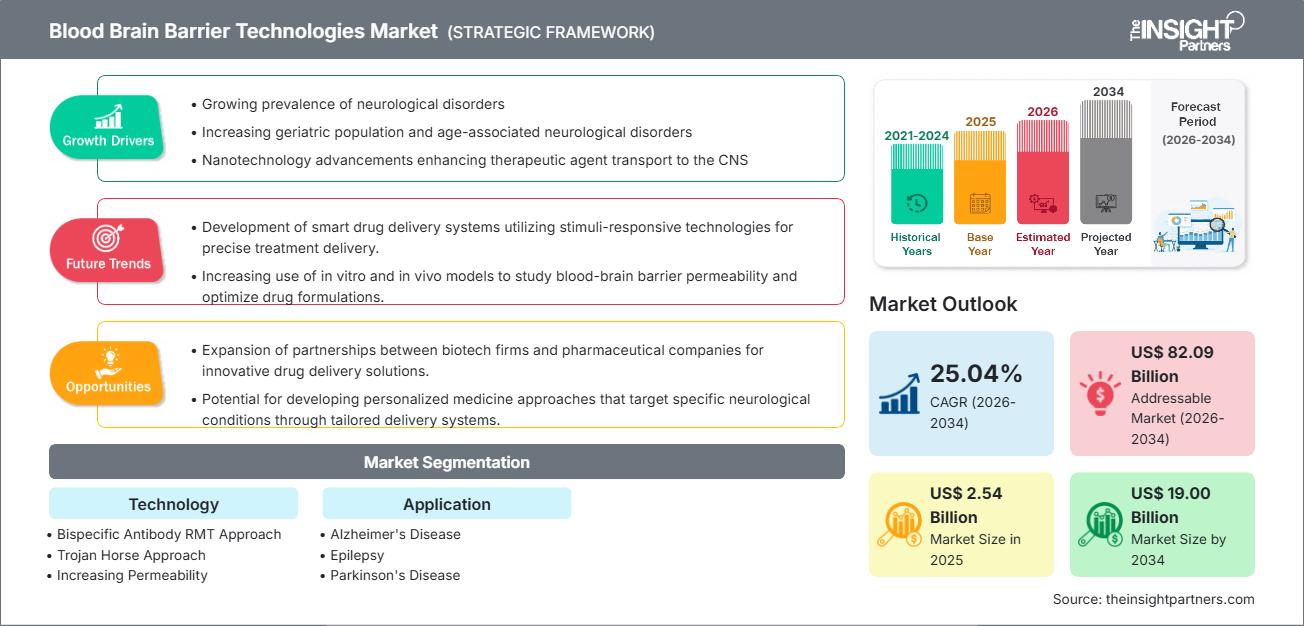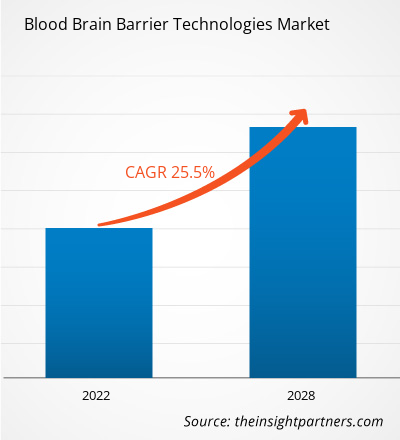预计到2034年,血脑屏障(BBB)技术市场规模将从2025年的25.4亿美元增长至190亿美元。预计在2026年至2034年的预测期内,该市场将实现25.04%的复合年增长率(CAGR)。
血脑屏障技术市场分析
血脑屏障技术市场预测显示,该市场将呈现爆发式增长,其驱动力主要来自全球范围内日益严重的神经系统疾病以及向中枢神经系统 (CNS) 输送有效疗法的持续挑战。市场扩张的主要动力源于大型制药和生物技术公司对神经科学研发的大规模战略投资。这些公司正迅速采用创新的药物递送平台,例如受体介导的胞吞作用 (RMT) 和靶向纳米颗粒,以克服血脑屏障的天然保护机制。监管机构为新型中枢神经系统疾病疗法提供快速通道认定,进一步促进了这一趋势,加速了旨在靶向药物渗透的新技术的开发和商业化。
血脑屏障技术市场概览
血脑屏障技术涵盖一系列精密复杂的方法和系统,旨在暂时调节或绕过高度选择性的内皮屏障,该屏障限制药物进入大脑和脊髓。该市场包括利用内源性转运途径的生物学方法,例如双特异性抗体和特洛伊木马载体;以及增强通透性的物理方法,例如聚焦超声 (FUS) 和渗透压破坏。这些技术对于释放大分子生物制剂(例如抗体和肽)以及其他通常对中枢神经系统疾病无效的药物的治疗潜力至关重要。通过实现脑实质内药物浓度的精确提升,这些技术有望彻底改变慢性神经系统疾病的治疗模式。
根据您的需求定制此报告
您可以免费获得任何报告的定制服务,包括本报告的部分内容、国家/地区层面的分析、Excel 数据包,以及面向初创企业和高校的优惠折扣。
血脑屏障技术市场:战略洞察

-
获取本报告的主要市场趋势。这份免费样品将包含数据分析,内容涵盖市场趋势、估算和预测等。
血脑屏障技术市场驱动因素和机遇
市场驱动因素:
- 神经系统疾病患病率上升和未满足的需求:包括阿尔茨海默病、帕金森病和多发性硬化症在内的神经退行性疾病的全球发病率不断上升,对能够治疗这些疾病的创新给药系统产生了迫切的高价值需求,而由于血脑屏障的挑战,这些疾病历来治疗不足。
- 对靶向中枢神经系统药物递送的需求日益增长:现代药物研发专注于高特异性、低毒性的治疗药物。血脑屏障技术能够实现这些药物的靶向递送,最大限度地减少全身暴露和潜在副作用,同时最大限度地提高病灶部位的治疗浓度。
- 生物技术和制药研发投资不断增长:研发资金正显著转向神经科学领域。各国政府和私募股权公司正大力投资专注于开发专有血脑屏障(BBB)平台的专业生物技术公司,这些平台能够降低大型制药合作伙伴中枢神经系统(CNS)药物研发管线的风险。
市场机遇:
- 开发非侵入性血脑屏障技术以提高患者依从性:聚焦超声(FUS)等技术能够暂时且精确地非侵入性地打开血脑屏障,这代表着巨大的发展机遇。与手术或脑室内给药方式相比,FUS有望提高患者依从性并实现重复给药。
- 随着亚太和拉丁美洲地区经济的日趋成熟,对专科医疗保健和先进生物制剂的投资不断增加,这为BBB平台开辟了新的市场,尤其是在医疗服务不足的庞大患者群体中。
- 战略合作助力加速临床试验和商业化:拥有新型血脑屏障(BBB)平台的生物技术公司与拥有丰富临床研发管线和商业化规模的跨国制药公司之间的合作至关重要。许可协议和合资企业将加速BBB赋能药物的测试和市场准入。
血脑屏障技术市场报告细分分析
血脑屏障技术市场根据促进药物运输的核心机制和所针对的具体疾病领域进行细分。
按技术分类:
- 双特异性抗体受体介导的胞吞作用(RMT)方法
- 特洛伊木马策略
- 提高渗透率
- 被动扩散
- 其他非侵入性血脑屏障技术
按申请方式:
- 阿尔茨海默病(AD)
按地理位置:
- 北美
- 欧洲
- 亚太地区
- 南美洲和中美洲
- 中东和非洲
血脑屏障技术市场区域洞察
The Insight Partners 的分析师对预测期内影响血脑屏障技术市场的区域趋势和因素进行了详尽的阐述。本节还探讨了北美、欧洲、亚太、中东和非洲以及南美和中美洲等地区的血脑屏障技术市场细分和地域分布。
血脑屏障技术市场报告范围
| 报告属性 | 细节 |
|---|---|
| 2025年市场规模 | 25.4亿美元 |
| 到2034年市场规模 | 190亿美元 |
| 全球复合年增长率(2026-2034 年) | 25.04% |
| 史料 | 2021-2024 |
| 预测期 | 2026-2034 |
| 涵盖部分 |
通过技术
|
| 覆盖地区和国家 |
北美
|
| 市场领导者和主要公司简介 |
|
血脑屏障技术市场参与者密度:了解其对业务动态的影响
血脑屏障技术市场正快速增长,主要受终端用户需求不断增长的推动,而这又源于消费者偏好的转变、技术的进步以及人们对产品益处的认知度不断提高。随着需求的增长,企业不断拓展产品和服务,持续创新以满足消费者需求,并把握新兴趋势,这些都进一步推动了市场增长。

- 获取血脑屏障技术市场主要参与者概览
血脑屏障技术市场份额地域分析
北美占据最大的市场份额,而亚太地区预计将在预测期内实现最快的增长速度。全球主导地位主要由区域研发集中度、知识产权保护以及有利于高风险、高回报中枢神经系统疗法的监管环境所决定。以下是各区域市场份额和趋势概述:
北美
- 市场份额:在血脑屏障技术市场占据主导地位,拥有最大的市场份额,这得益于领先的制药公司高度集中、庞大的研发基础设施以及专门针对血脑屏障平台生物技术初创公司的巨额风险投资。
- 关键驱动因素:阿尔茨海默病和帕金森病领域广泛的研发管线。
- 趋势:高度重视将先进的RMT和双特异性抗体技术转化为后期试验的临床应用。
欧洲
- 市场份额:占据相当大的市场份额,这得益于政府大力支持的研究计划(例如,欧洲地平线计划对神经科学的资助)以及该地区日益严重的中枢神经系统疾病负担。
- 关键驱动因素:院校与行业伙伴之间强有力的学术合作。
- 趋势:非侵入性物理 BBB 调节技术(特别是聚焦超声)在欧洲研究医院中得到越来越广泛的应用。
亚太
- 市场份额:增长最快的地区,这得益于医疗保健研究投资的快速增长、神经系统疾病患者群体的扩大以及专门的生物技术中心的建立。
- 主要驱动因素:专注于早期 BBB 创新的私营生物技术公司快速增长。
- 趋势:本地生物技术公司与西方制药公司合作,共同开发针对区域市场的 BBB 药物,这种合作模式得到了广泛采用。
南美洲和中美洲
- 市场份额:新兴市场,机遇尚处于萌芽阶段但正在不断增长,主要由制药行业的扩张和专业护理服务的改善所驱动。
- 关键驱动因素:旨在解决神经系统健康差异的公私健康伙伴关系。
- 趋势:初步采用成本效益高的特洛伊木马方法和利用被动扩散增强剂的通用药物再利用。
中东和非洲
- 市场份额:发展中市场具有很高的增长潜力,这得益于政府对医疗基础设施扩建的大量投资以及对建立医疗研发中心的重视。
- 关键驱动因素:国家电子健康战略优先考虑专科护理,包括神经病学。
- 趋势:实施需要使用尖端 BBB 技术的专业神经科学研究项目,主要通过与全球领先企业的合作来实现。
血脑屏障技术市场参与者密度:了解其对业务动态的影响
血脑屏障技术市场的竞争环境瞬息万变,既有大型制药公司,也有小型专业生物技术平台开发商。竞争的焦点不仅在于最终药物的商业化,更重要的是,还在于证明其专有药物递送技术本身具有卓越的安全性、有效性和可扩展性。
这种竞争环境促使供应商通过以下方式实现差异化:
- 已验证的递送平台:在早期试验(I期和II期)中证明 BBB 技术的临床安全性和有效性是主要竞争优势。
- 战略许可和合作:规模较小的生物技术公司专注于将其专有的 BBB 技术授权给大型制药公司,以资助开发并确保广泛的市场覆盖。
- 靶向特定受体:开发下一代双特异性抗体,以最大限度地减少脱靶效应,并通过新型或未充分利用的 BBB 受体最大限度地提高大脑吸收率。
- 非侵入式模式整合:专注于将物理破坏技术(如 FUS)与特定的候选药物相结合,以提供完整的非手术治疗方案。
在血脑屏障技术市场运营的主要公司有:
- 梯瓦制药工业有限公司
- F. Hoffmann-La Roche 有限公司
- 礼来公司
- 辉瑞公司
- 强生服务公司
- 百时美施贵宝公司
- Bioasis Technologies Inc.
- Fabre-Kramer制药公司
- Abliva AB
免责声明:以上列出的公司不分先后顺序。
血脑屏障技术市场新闻及最新进展
- 罗氏制药有限公司:罗氏已开发出其专有的 Brainshuttle™ 技术,该技术可使抗体和寡核苷酸等大型治疗分子穿过血脑屏障。目前,该平台正针对神经退行性疾病和罕见中枢神经系统疾病进行临床评估,进一步巩固了罗氏在靶向脑部递送解决方案领域的领先地位。
-
辉瑞公司:辉瑞正在开发突破血脑屏障的创新方法,例如腺相关病毒载体和基于纳米颗粒的递送系统。这些技术旨在改善脑转移瘤和罕见神经系统疾病的治疗方案,这与辉瑞在基因治疗和肿瘤学领域的战略重点相一致。
- 强生服务公司:强生重点介绍了其与VECT-HORUS的合作,该平台能够实现药物穿过血脑屏障。这项技术目前也在研究用于治疗和诊断多种神经退行性疾病,进一步体现了强生对中枢神经系统治疗的承诺。
血脑屏障技术市场报告涵盖范围和成果
《血脑屏障技术市场规模及预测(2021-2034)》报告对市场进行了详细分析,涵盖以下领域:
- 血脑屏障技术市场规模及预测,涵盖全球、区域和国家层面的所有主要市场细分领域。
- 血脑屏障技术市场趋势,以及市场动态,例如驱动因素、制约因素和关键机遇。
- 详细的PEST和SWOT分析。
- 血脑屏障技术市场分析涵盖关键市场趋势、全球和区域框架、主要参与者、法规和近期市场发展。
- 血脑屏障技术市场的行业格局和竞争分析,包括市场集中度、热力图分析、主要参与者和最新发展。
- 公司详细简介。
- 历史分析(2 年)、基准年、预测(7 年)及复合年增长率
- PEST和SWOT分析
- 市场规模、价值/数量 - 全球、区域、国家
- 行业和竞争格局
- Excel 数据集
近期报告
客户评价
购买理由
- 明智的决策
- 了解市场动态
- 竞争分析
- 客户洞察
- 市场预测
- 风险规避
- 战略规划
- 投资论证
- 识别新兴市场
- 优化营销策略
- 提升运营效率
- 顺应监管趋势






















 获取免费样品 - 血脑屏障技术市场
获取免费样品 - 血脑屏障技术市场